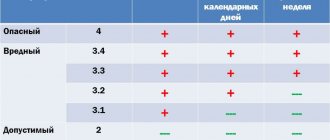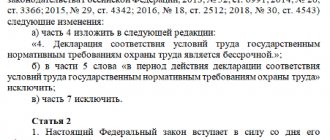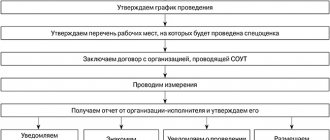Briefly about working conditions and their classes
According to the law, working conditions in factories have a certain hazard class, which is assigned to a workplace depending on what potentially unsafe or harmful factors occur there. There are four classes in total: the first, the safest, i.e. workers can carry out their work duties without any harm to health. The second - with minimal negative effects on the body, the third - is already quite harmful, when the negative impact on a person is quite noticeable.
And finally, the fourth hazard class: high, when working conditions are characterized by the maximum degree of threat to the life and health of the worker.
In the third and fourth classes, the management of enterprises must provide subordinates with all the necessary means of protection; in addition, some categories of personnel are entitled to compensation for harmfulness, which is issued either in the form of natural food products (for example, milk and dairy products), or in the form of additional cash allowances.
Actions of the organization's management after a special assessment
Job assessment work begins with identification.
An expert from a third-party organization examines the provided technical documentation for the equipment used in production and the results of previously conducted workplace certifications.
The only workplaces that are not subject to identification are:
- employees whose professions correspond to preferential Lists 1, 2;
- labor legislation or other industry regulations provide for guaranteed benefits and compensation for harm;
- Based on the results of the previous assessment, the presence of harmful factors affecting personnel was established.
A declaration on workplaces drawn up by the employer or an expert organization (depending on the agreed terms of the contract) is sent to the territorial labor inspectorate with optimally safe conditions.
The remaining workplaces, which, after identification, are determined to pose a certain danger to the worker’s body or a risk to life and health, are examined in accordance with established methodological recommendations for conducting assessment work.
The employer must provide all the conditions for conducting the necessary laboratory tests, the possibility of taking measurements and measurements, and provide technical documentation for buildings, premises, and structures used in production.
Laboratory tests and analysis are also carried out at workplaces that cannot be identified, since it is initially assumed that the working conditions in these areas are harmful, which provides certain benefits for attracting employees.
The results of the studies are documented in the form of protocols and compared with established standards.
Based on the percentage of excess of harmful factors to the maximum permissible standards, a determination is made to assign each workplace to a hazardous class.
Working conditions may be recognized:
- optimal when, during the work process, employees are not exposed to any extraneous factors that could harm their health;
- acceptable when exposure to factors harmful to the body is present to an insignificant extent, which allows a person to fully restore strength after rest and remain functional;
- harmful working conditions, which are divided into 4 degrees; the more a person is exposed to harmful factors, the higher the degree.
- dangerous conditions under which it is impossible to work at all, and sometimes it is even impossible to carry out tests due to the high degree of risk to the health and life of people.
In this case, the workplace must be completely re-equipped or closed.
Since an employee of an enterprise during a work shift may be exposed to several factors (for example, noise and insufficient lighting, uncomfortable posture, etc.) that are harmful to his health, the specialist’s task is to give a final assessment of working conditions in the workplace.
It is according to the report provided to the manager that additional benefits can be assigned or canceled to employees.
Having received a report on the conclusions drawn and the established hazard classes of workplaces, recommended measures to improve working conditions, the employer must familiarize the employees with signature of the conclusions of the assessment within 30 days (if the person is on vacation, a business trip, or on sick leave, the period is extended).
In the event that a workplace was previously considered to have an acceptable degree of harmfulness, if after a special assessment it is determined that it is determined to have hazardous working conditions, this must be reflected in addition to the Employment Agreement with the employee.
According to Art. 18 Federal Law No. 426, the employer must transfer information about the examination performed to the Federal State Information System for recording results in electronic form, also post information on its own website, if available, and notify the Social Insurance Fund.
The issuance of a special order upon completion of the assessment work is not provided, but, if it is necessary to make changes to the conditions for providing benefits and compensation to workers involved in hazardous or harmful areas of work, a corresponding order is prepared.
How are working conditions assessed?
In order to properly assess working conditions, the first step in the organization is to issue an appropriate order. Through it, a special commission is appointed, which may include not only company employees, but also representatives of specialized expert services. Next, production is visited, the necessary measurements are taken, which are compared with the standards established by law, and based on their results, unfavorable factors are identified.
To complete the assessment of working conditions, an order is also issued, summarizing the results of the procedure, prescribing measures to eliminate the violations found, and appointing responsible persons. In addition, all employees of the enterprise must be familiarized with the results of the commission’s activities against signature.
It should be noted that the assessment of working conditions should be carried out at certain intervals, but at least once every five years. If this norm is violated, the management of the organization, and indeed the legal entity itself, may be subject to serious administrative punishment.
What should the order contain?
Covering letter for the declaration on SOUT (sample)
Note! An order to conduct a technical assessment, like any other document, must have an introduction, main text and conclusion.
In accordance with the regulations of Federal legislation, the form must reflect the following information:
- at the top of the document, the details of the business entity are written down (many people use letterhead for these purposes, the advantage of which is the presence of a header with the relevant data);
- under the details the date of drawing up the order, place, registration number is indicated;
- a few lines later, in the center, “order” is written in large letters;
- after the omission, the main text is written containing information about the start of the assessment of working conditions from a certain date;
- a commission is appointed, the names of the employees entrusted with the mission to conduct an inspection of the production area are indicated;
- in the main section, the business entity must make a reference to the norm of Federal legislation, which will be the basis for issuing the order (you can also indicate the number of the local regulatory act that the organization is guided by in the process of work).
Order on the creation of a commission to conduct
The head of the company may, by a separate order, appoint members of the commission to conduct inspections of workplaces. The basis is a standard document that specifies the details, registration number, lists all the names and positions of employees involved in the inspection, describes the procedure and powers.
Quality assessment of SOUT
Sample order for carrying out SOUT
Business entities can use a standard order for the completion of SOUT, sample 2021. They just need to enter their data and adjust the text to suit their type of activity.
Typical sample order for completion of SOUT
The order to complete the SOUT is issued by the management of the organization or an individual entrepreneur. This document must be issued on paper, A4 format. The order must be issued within a week after all activities related to the special assessment of working conditions have been completed. Due to the fact that the Federal legislation does not provide for a unified form of this document, business entities can create it:
- on a computer and then printed;
- by hand;
- through other printing technology.
When SOUT is not carried out
To ensure that regulatory authorities do not have any questions for the management of the organization, the order to complete the SOUT must comply with all standards for maintaining business records. A business entity can establish a document template in its accounting policy that it will use throughout its entire activity.
How to certify a document
The very first signature in the document should always belong to the director or employee temporarily in his place (since it is from the main person of the enterprise that such orders are always issued).
The form must also contain the autographs of the employees to whom the order is most directly related, as well as those who are entrusted with monitoring its implementation.
Moreover, in some cases, signatures confirming familiarization with the order can be collected in a separate document (act or statement).
How to record the creation of a document and organize storage
All orders issued on behalf of the head of the company must be registered. To do this, it is necessary that the organization has a special journal for recording administrative acts. The number and date of the order are entered here, as well as its short name, if necessary.
After the order is registered, it should be placed in a folder with other similar papers and given to the responsible employee for safekeeping. The storage period must comply either with the standards specified in the legislation of the Russian Federation, or with the rules of the accounting policy of the enterprise.
What to consider when developing an order (instruction)
The order to complete activities to assess working conditions is a document that summarizes the results of the entire inspection. It must necessarily contain recommendations and propose effective measures aimed at eliminating the violations identified by the commission. The order must contain the names and positions of the persons responsible for correcting errors. In the future, when conducting an inspection of the activities of a business entity, the supervisory authority will check the result of eliminating the identified violations. If the errors are not corrected, the responsible persons specified in the order will be held administratively liable.
Note! The order on the completed SOUT is handed over to all employees of the organization for review, against signature in the appropriate accounting register.
Procedure for carrying out SOUT
The head of a commercial organization or individual entrepreneur can use a sample posted on the Internet when drawing up an order to create a commission for carrying out special assessments. On thematic sites, for example, on preschool educational institutions, standard documents are offered to business entities that take into account all the requirements of Federal legislation. Such orders can be used as a basis, making adjustments in accordance with the specifics of your business area.
Sample order for completion of a special assessment of working conditions
If you need to make an order to complete a special assessment of working conditions, look at its sample and read the comments to it. They will help you make the required document correctly and without errors.
- The first part of the order is quite standard: the name of the organization, the form number, the place (locality) and the date (month, year) of its formation are written here.
- Next comes the main section. First, you need to add a basis here, i.e. a link to an article of law or an internal act of the company that is directly related to this order. The rationale should also be noted - the actual reason for creating the order.
- Then move on to the actual instructions for completing the work environment assessment. Include here a requirement to take action to improve the workplace and correct identified violations.
- Appoint responsible employees for familiarizing staff with working conditions, harmful factors, issuing personal protective equipment, for drawing up additional agreements to employment contracts taking into account the hazard class, for introducing hazard pay.
- If you consider it necessary, you can supplement the form with other information that you consider important in your situation.
- Finally, do not forget to collect all the necessary autographs under the document.
Order on the creation of a commission on SOUT
It is a document by which the employer:
- Creates a special assessment commission.
- Determines the terms of its work, the rights and responsibilities of the chairman and members of the commission.
- Approves the schedule for the special assessment.
- Appoints those responsible for the procedure for interaction and work with the organization’s experts, who directly carry out measurements and classify the results.
- Establishes the procedure for familiarizing employees with the results of the SOUT.
- Determines a list of measures aimed at improving working conditions based on the results of a special assessment.
Sample order for the creation of a commission on SOUT (schedule)
When creating a commission, it must be taken into account that the total number of its members must be odd.
The employer can approve the schedule for conducting a special assessment by an appendix to the order on the creation of a commission on special assessments or by a separate local regulation (at its discretion).
The main rights and responsibilities of the commission are:
- providing the necessary documents and information to the organization’s experts who conduct the special assessment;
- taking measures to prevent any actions that could narrow the range of issues and negatively affect the results of the special assessment;
- informing the enterprise personnel on the issues of holding this event;
- familiarization of enterprise employees with the progress and results of the special assessment.
An employee whose workplace is subject to special assessment has the right:
- be present during it;
- contact the employer and experts for clarifications and suggestions on the issues of conducting special educational work.
The rights of employees should not be ignored, otherwise it may be considered discrimination or disregard for the rights of the employee, which in any case is unfavorable for the employer.
Sample order for a special assessment of working conditions (unscheduled)
When preparing an order to conduct a special assessment, you must be guided by the following documents:
- Federal Law No. 426-FZ dated December 28, 2013;
- By Order of the Ministry of Labor dated January 24, 2014 No. 33n;
- By Order of the Ministry of Labor dated 02/07/2014 No. 80n.
The federal law regulates the general principles and basic provisions on the procedure for carrying out special operational assessments in an organization.
Order 33n approves the Methodology for conducting a special assessment of working conditions.
Order 80n establishes the form and procedure for filing a declaration based on the results of a special assessment of working conditions.







